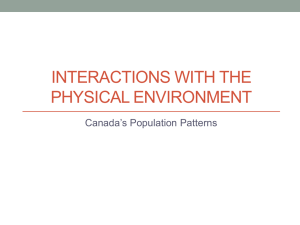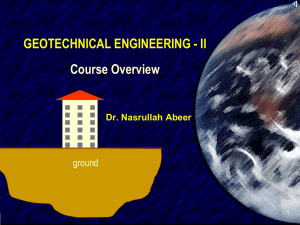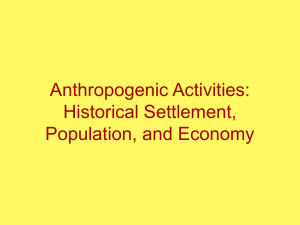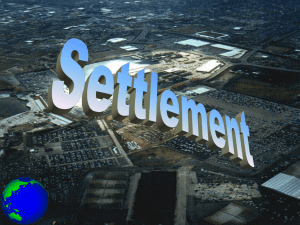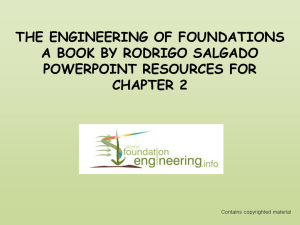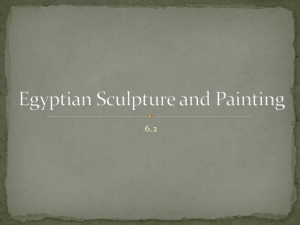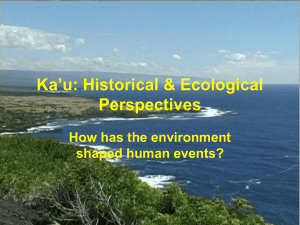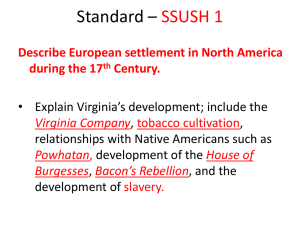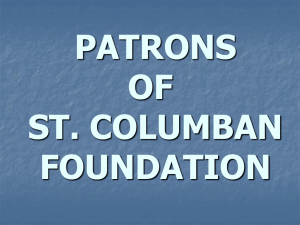Settlement
advertisement
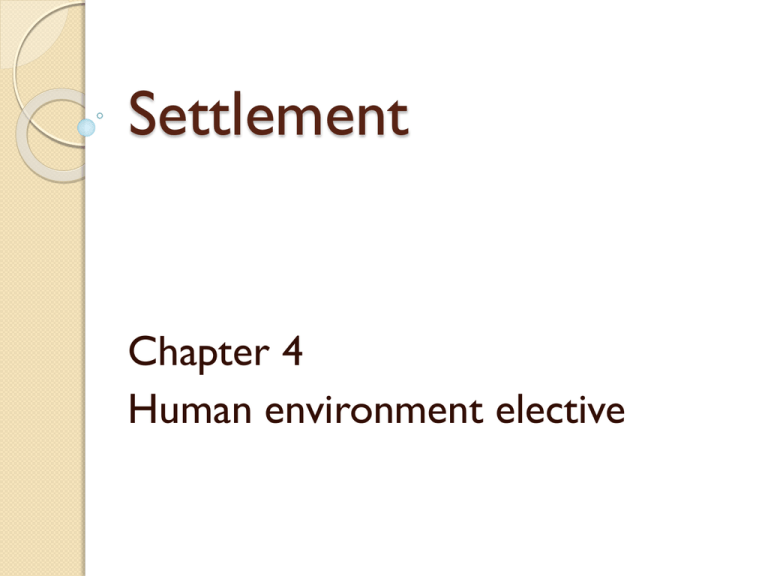
Settlement Chapter 4 Human environment elective Settlement: a place where people live. Settlements vary in size, location and functions. Site: the piece of land a settlement is built on. Physical factors often determine the location of a settlement as things like slope, water supply, defence, building materials and resources often were and are considered. By examining the land of an area you can explain why or why not this site is suitable for settlement Situation: this is when you describe the settlement in relation to the surrounding lands and other towns. The land around a settlement is the area the settlement might expand into and is important to recognise positive and negative factors in the situation. Drainage: water supply is vital but the land must be well drained (fear of flooding) Soil quality: Is the surrounding land fertile for crops Altitude: lowland areas are easier to build upon and farm in contrast to exposed highland areas. Aspect: the direction an area is in can see an increase in sunshine hours, temperatures and less rainfall. Amount of people per km2 Spread of people across an area • Dispersed / Random • Clustered / Nucleated • Linear / Ribbon • Absent / None 2/3 details on why and when each type of pattern occurred FAVOURED SITES •Early settlers wanted a water supply so chose sites beside a water (river, sea) •Early invaders chose river / coastal sites for defence and ease of escape •Early Industrial revolution, factory owners chose sites beside water for energy supplies •They also chose sites beside resources such as coal and iron ore •Recently, government policies determine the site of new towns (Adamstown, Shannon) •Settled upland areas offer some kind of natural defence, shelter and a sunnier aspect and are not prone to flooding •Dry point settlement were established above the regular flood levels along rivers •Routeways through mountains led to the development of settlements at the meeting place (focus) of all routes 7000BC – Old Stone Age • Middens (ancient rubbish heap) •Nomadic hunter-gathers No fixed home territory Wandered the landscape in search of fruits and animals •Stone weapons and tools which were found by archaeologists •Remains of food found in middens showing what they ate and cooked 3500BC – New Stone Age (Neolithic) settlement Mainly tombs: Megalithic tombs, barrows, portal dolmens, passage graves and court cairns, stone circles, standing stones, rock art, earthworks, fulacht fia •Cultivated wild grasses and kept animals = Ireland’s 1st farmers •Built burial chambers on high places in the landscape (hill) to remember their dead •Tombs found on fertile landscapes, close to water supply and at dry points above a river •Sheer size of tombs shows the skill used in handling huge stones and boulders •Little evidence of houses but thought to have been tentlike structures with animal skin stretched over curved branches •Understood sun and seasons (Newgrange) and aligned tombs to the rising sun 2000BC – Bronze Age settlement Copper mines, barrows, cist graves and wedge tombs •Much smaller graves •Their tombs (cist and wedge tombs) were buried in small barrows or stone chambers •Found mainly on low-lying land •Many tombs found close to copper mines which was needed for making bronze and reflected use of resources 600BC-IRON AGE Celtic Settlement Mainly homes: Ring forts, promontory forts, hill forts and crannogs, barrows •Isolated dwellings across countryside •Used landscape for shelter, farming and dry points •Homes were built on defensive sites (hillltops, cliff edges and lakes) •Ring forts built of earth and stone •Earthern ringforts (raths) in Ireland east and stone ringforts ( dun/caiseal) in ireland west where there is less soil •Crannogs main settlement in lakes and poorly drained areas of the midlands •Barrows built as burial places 500-800AD – EARLY CHRISTIAN Mainly religious sites: Holy wells, cross-inscribed stones, round towers, high crosses, monasteries, churches, graveyards •Lived near religious sites •Sites chosen were isolated for peaceful prayer and defence purposes •Location of church often liked to an important existing well etc. •Houses built of wattle and daub (interwoven tree stems packed with mud) and enclosed with circular fences or embankments •Crosses carved on Stone Age standing stones. Shown as cross-inscribed stones •Monasteries and round towers were important and social centres 7000BC Old Stone Age 3500BC New Age 2000BC Bronze Age Settlement 600BC Iron Age/Celtic Settlement 500BC Early Christian Settlement 800 / 1000AD Vikings 1100 / 1500 Medieval / Norman era 1500 / 1700 Plantation era 1700 / 1800 Georgian settlements 1900 / 2000+ Industrial – Resort – Dormitory – New Towns Aim: To protect the future of rural Irish society Duration: 2007 -2013 Investment: €183.7 billion Methods: 1. Transport links (rural to urban) 2. Support rural-based industries (Farming/Fishing/Forestry) 3. Village renewal (make villages more attractive to live in) 4. Boost tourism in rural areas 5. Improve water supplies 6. Provide education and training schemes Each county in Ireland has its own development plan to control urban and rural settlement. The plan includes lists of committees, organisations, agencies and groups who deal with local concerns and development. Functions are the services and activities that an urban area provides for its residents and people of the surrounding areas A central place is a town which provides goods and services for the people who live in and around the town. Threshold: The population needed to keep a services in business Range: The maximum distance people will travel for a product or service Frequency of demand: How often a service is needed. Rank order: a range of cheap daily items (milk, bread etc) to expensive and rare goods (car, yacht etc) Urban settlements are grouped according to their size and the number of functions they have. Basically this is a ranking system from smallest to largest. It makes sense that the larger the urban area….the more functions the city will have….supply and demand.

